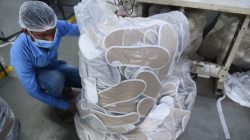To gather every last stem and ribbon, Mr. Patrikis is on the phone constantly, negotiating with 15 distributors to get the best deals.
“If you don’t know how to buy from the wholesalers, the wholesalers are going to buy you,” he said.
Depending on a stem’s length, the size of the bloom and the nation of origin, a dozen roses in New York City can cost a customer from $10 from a street vendor to more than $120 from a high-end florist. Mr. Patrikis prefers the Explorer variety of red roses, which he said tend to have larger blooms and stay fresh longer than some other varieties.
Sales in the flower industry, where same-day, local deliveries are common, shot up early during the pandemic. So did the price of doing business, with rising fuel costs, a flower shortage and supply chain problems.
The elevated prices put pressure on longtime florists like Mr. Patrikis, whose shop was one of five on his block around 2010. Ditmars Flower Shop is now the last one left.
“We were never busier in our lifetime,” Mr. Patrikis, 37, said about reopening in time for Mother’s Day in 2020 after the earliest closures in the pandemic. “We didn’t sleep for a week.”
Americans spent nearly $73 billion on flowers, seed and potted plants last year, up 48 percent from 2019 after adjusting for inflation, according to the U.S. Bureau of Economic Analysis.
But there are signs of instability in the industry.
Troy Conner, the president of Kendall Farms, a large flower farm in Fallbrook, Calif., that sells to supermarket chains and wholesalers, said that many of his costs had skyrocketed, too.
Beginning last year, he said, demand for flowers had started to level off. He said he might repurpose some land reserved for growing sunflowers, once a profitable crop, to raise goats instead.
At Ditmars Flower Shop, Mr. Patrikis said, the profit margin has shrunk since the start of the pandemic, from 20 to 30 percent, down to 10 to 20 percent. The shop might have sales of $150,000 and $300,000 a month.
He said higher sales volume had allowed him to make up the difference so far. This year, he expects to sell more than 100,000 red roses, his most popular item, up from 70,000 in 2019. On Valentine’s Day, the busiest holiday, he sells 15,000 roses.
The Society of American Florists, a trade group, predicts that the number of flower shops in the country will drop to 11,000 by 2026, partly because of retirements and consolidation. There were 11,600 in 2021.
In last year’s third quarter, there were 398 florists in New York City, down from 432 in the same period in 2019, according to James Parrott, a director with the Center for New York City Affairs at the New School.
Mr. Patrikis’s father, John, a Greek immigrant from the island of Nisyros, sold flowers in the subway and eventually opened his first flower shop in Astoria in 1983 before moving to the current 1,500-square-foot shop in 2008.
Mr. Patrikis said he felt obliged to stay in the family business. Sales remain brisk, largely because he has a broad range of clients — weddings, funerals, Greek Orthodox churches. Still, he worries about consumer spending habits, now that most pandemic-era government benefits have dried up.
He’s optimistic about his own future, though, because his family bought their building in 2003.
“The only ones who are going to be left are the ones who own their buildings,” he said.
Ben Casselman contributed reporting.
Produced by Eden Weingart, Andrew Hinderaker and Dagny Salas. Development by Gabriel Gianordoli and Aliza Aufrichtig.
Sumber: www.nytimes.com












